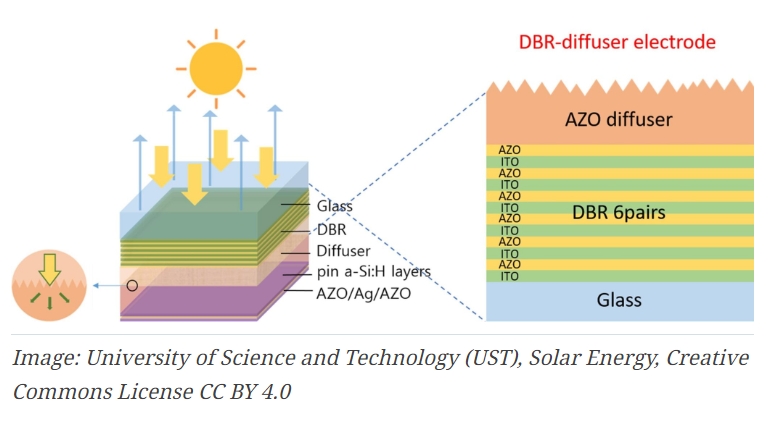South Korean scientists have developed a new building-integrated photovoltaic (BIPV) solar cell featuring a distributed Bragg reflector (DBR) electrode. This innovation is expected to enhance light scattering and meet aesthetic standards.

South Korean researchers have developed a BIPV cell incorporating a transparent distributed Bragg reflector (DBR) electrode.
The DBRs consist of alternating dielectric layers, commonly serving as reflectors and dielectric mirrors, and their multilayered composition alternates between high and low refractive indices, resulting in customizable reflection spectra.
The DBR structures exhibit a distinct blue hue and use transparent conductive oxides (TCOs) derived from thin-film aluminum-doped zinc oxide (AZO) and indium tin oxide (ITO). This choice of materials reportedly enhances light scattering. The connection between TCOs and the DBR electrode incorporates a diffuser layer, serving as a transparent front electrode.
“The AZO diffuser layer was chemically etched, and the light-scattering structure was controlled by varying the etching time,” the researchers said. “As the etching time increased, the reflectance spectra tended to decrease over the entire wavelength range, owing to the textured surface of the diffuser layer.”
The researchers said that the textured PV cells exhibit greater intensity in external quantum efficiency (EQE) across the entire wavelength spectrum when contrasted with flat PV cells. EQE signifies the efficiency of power conversion, calculated by considering all incident sunlight or photons.
“The absorption of PV cells was improved by enhanced light scattering with a higher etched DBR-diffuser electrode, but the spectral response of the EQE decreased in the highest light scattering structure of 150 second,” explained the scientists.
They said that they will now investigate these interfacial defects in solar cells with increased light scattering.
“The optimization results of the DBR electrode and diffusion layer will be applied not only to a-Si:H but also to other colored thin film solar cells and will help BIPV to research utility and aesthetics,” they said.